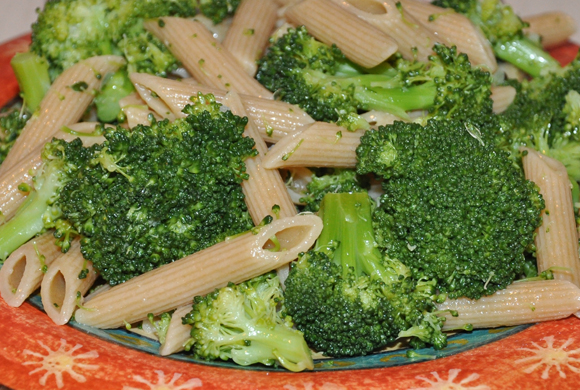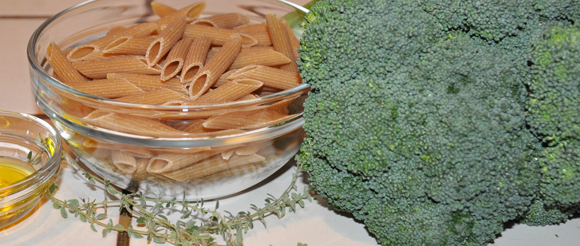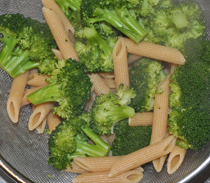November 8, 2023. Maybe the ultimate quick, cheap-and-easy, low-glycemic, super-high-nutrition meal. Just add water. And boil. But not for too long.
Because al dente pasta – cooked just long enough to be tender, not crunchy – has an unusually low glycemic index. Cook your pasta a few minutes longer – to that soft, flaccid state – and its glycemic index actually increases about thirty percent. Use whole grain pasta and cook it al dente like I just did and you’ve got a high-quality carbohydrate with a glycemic index of around 30. Four ounces (one cup, cooked) of it delivers a glycemic load of just 8.6. Add 3 cups of broccoli for a nearly complete meal with a glycemic load of about 14 with just 500 calories. Including two teaspoons of olive oil.
That olive oil isn’t just fragrant and delicious. It makes a big contribution to the feeling of satisfaction you get from this meal. And it’s what you need to get the actual nutritional value of the fat-soluble nutrients in your broccoli. It may not be as cool as that other cruciferous vegetable, kale, but two cups of broccoli delivers a day’s worth of Vitamin A and two days of Vitamin C. Not to mention fiber and a range of phytonutrients and carotenoids, Vitamins E and K and other micronutrients including iron, calcium, potassium and zinc. Don’t lose any of this good stuff by by over-cooking: here’s why steaming broccoli for just four minutes is the winning Way.
Most important: this dish wins for flavor. Nutty, slick, substantial whole-grain pasta. Sweet, earthy broccoli with just a little crunch to it. Aromatic olive oil and fresh herbs. You’re in Italy. You’re wondering why they call the Mediterranean Diet a diet.
Ingredients
Per serving
1 cup (4 ounces) of whole wheat pasta, cooked
3 cups of broccoli florets
2 teaspoons of olive oil
Option: 1/2-teaspoon of fresh thyme, basil or other herbs
Salt and/or pepper to taste
How To Make It
Quickly. Boil a pot of water, salted or not. Add the pasta to boiling water and cook for two minutes less than the package instructions call for; 8 minutes, for example. Four minutes before you expect the pasta to be done, add the broccoli.
Taste the pasta at the al dente time. Make sure it’s cooked through. Softened but firm, not at all crunchy. Remove and drain the pasta and broccoli. Toss with the olive oil and herbs.
Quick. Serve it. Inhale it. Love it. Eat slowly. So simple, so easy. So tasty and satisfying. So not contributing to belly fat.
Cost-Benefit Analysis
About $2 per serving of this deeply aromatic and flavorful meal. That you prepare in less than 15 minutes. The low-glycemic load pasta dish that delivers a day’s worth of Vitamin A and two days of Vitamin C. Not to mention fiber and a range of phytonutrients and carotenoids, Vitamins E and K and other micronutrients including iron, calcium, potassium and zinc.
Cost Comparison
$15.99 for the frozen, reheated capellini with tomatoes and basil at The Olive Garden. Where “al dente” doesn’t appear on the menu or your table. Eight times more expensive than the fresh, nutritious, delicious meal you can prepare in less time than it takes to put in your order at Olive Garden.
Let’s Do The Math
12 ounces of today’s Way: 507 calories you can jog away in 45 minutes. The Olive Garden’s capellini pomodoro: 490 calories in just 8 ounces. More important: the Way’s glycemmic load is about 14. The Olive Garden’s: about 50! All calories are not created equal!
The Pasta Index
From the University of Sydney’s definitive Glycemic Index database: “Pasta has a low GI because of the physical entrapment of ungelatinised starch granules in a sponge-like network of protein (gluten) molecules in the pasta dough. Pasta is unique in this regard. As a result, pastas of any shape and size have a fairly low GI (30 to 60) … Pasta should be cooked al dente (‘firm to the bite’) … Overcooking boosts the GI. Although most manufacturers specify a cooking time on the packet, don’t take their word for it. Start testing about 2-3 minutes before the indicated cooking time is up.
“But watch that glucose load. While al dente pasta is a low GI choice, eating too much will have a marked effect on your blood glucose. A cup of al dente pasta combined with plenty of mixed vegetables and herbs can turn into three cups of a pasta-based meal and fits easily into any adult’s daily diet.“



